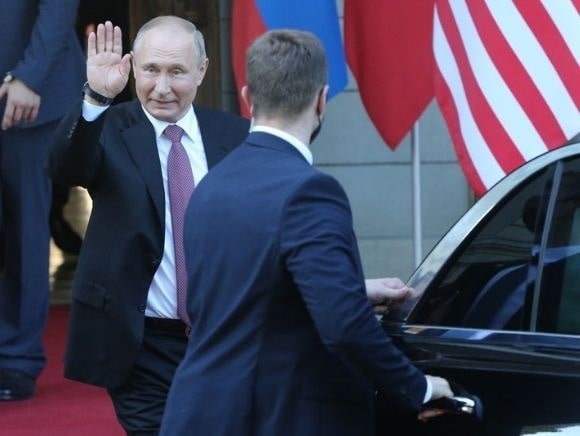On Jan. 10, delegations from the United States and Russia met in Geneva to avert a war over Ukraine’s engaging in closer relationship with the West. However, would NATO, the U.S., and members of the European Union really engage in open warfare over Kiev’s desires? Listening to the threats flying between the principal actors in this geopolitical brouhaha, one might think so. To defuse the tensions and avoid a military clash, Biden’s Deputy Secretary of State Wendy Sherman and Russian Deputy Foreign Minister Sergei A. Ryabkov met to find a diplomatic solution to the standoff.
 A New York Times analysis of the first meeting in a week-long series in Geneva explained Moscow “insists its demands go well beyond arms control and involve a wholesale redrawing of the security map in Europe, which the Kremlin claims the West forced upon a weak Russia after the collapse of the Soviet Union.” According to The Times, the Russian foreign minister characterized the opening discussions as “difficult, long, very professional, deep, concrete without attempts to gloss over some sharp edges.” Nonetheless, Ryabkov repeated the Kremlin’s position: NATO must put an end to allowing Central and Eastern European countries to be members of the alliance.
A New York Times analysis of the first meeting in a week-long series in Geneva explained Moscow “insists its demands go well beyond arms control and involve a wholesale redrawing of the security map in Europe, which the Kremlin claims the West forced upon a weak Russia after the collapse of the Soviet Union.” According to The Times, the Russian foreign minister characterized the opening discussions as “difficult, long, very professional, deep, concrete without attempts to gloss over some sharp edges.” Nonetheless, Ryabkov repeated the Kremlin’s position: NATO must put an end to allowing Central and Eastern European countries to be members of the alliance.
In her assessment of the discussion, Sherman reiterated the established U.S. and NATO positions and pushed back on “security proposals that are simply non-starters for the United States.” As Liberty Nation reported, the primary issue is that the United States and its NATO allies must never allow Ukraine to join the alliance. The Biden administration has been very clear on this point. As a sovereign nation, Ukraine can establish alliances with whatever organizations it chooses. The Kremlin cannot dictate what other countries must or must not do. Emma Farge, writing for Reuters, quoted Sherman:
“We will not allow anyone to slam closed NATO’s open-door policy, which has always been central to the NATO alliance. We will not forego (sic) bilateral cooperation with sovereign states that wish to work with the United States, and we will not make decisions about Ukraine without Ukraine, about Europe without Europe, or about NATO without NATO.”
What appears to be tough negotiating positions on both sides are cast against a backdrop of serious threats of military action. On Jan. 7, according to a Defense News article by Joe Gould, Biden’s Secretary of State Antony Blinken warned: “We’re prepared to respond forcefully to further Russian aggression, but a diplomatic solution is still possible and preferable – if Russia chooses it.” For his part, Russian President Vladimir Putin threw down the gauntlet at the end of December. As reported in Skynews, during a speech to military leadership in Moscow, Putin blamed “the West as tensions mount over Ukraine” and threatened, “If the aggressive line of our Western colleagues continues, we will take adequate military-technical response measures and react harshly to unfriendly steps.”
 Putin raised the United States backing out of the Intermediate-Range Nuclear Forces (INF) treaty as one of the pretexts for his hostile rhetoric. However, as LN pointed out in its report, “Russia Threatens to Deploy Nuclear Missiles in Europe,” only Russia has developed and deployed nuclear-capable missiles previously prohibited by the INF agreement. What remains to be seen in subsequent meetings is what the Biden administration is willing to give up to de-escalate the hostilities on Ukraine’s border. An NBC News report suggests that the White House might put on the table the withdrawal of U.S. forces and “scaling back U.S. and Russian troop deployments and exercises in Eastern Europe.” Included could be the number of troops stationed in the Baltics and Poland. Having fewer U.S. and allied troops on Russia’s border is precisely what Putin wants. In this scenario, the United States withdraws forces to where it takes weeks to redeploy them in an emergency, and while Moscow pulls its forces back from Ukraine’s border to where they can be back in a few days.
Putin raised the United States backing out of the Intermediate-Range Nuclear Forces (INF) treaty as one of the pretexts for his hostile rhetoric. However, as LN pointed out in its report, “Russia Threatens to Deploy Nuclear Missiles in Europe,” only Russia has developed and deployed nuclear-capable missiles previously prohibited by the INF agreement. What remains to be seen in subsequent meetings is what the Biden administration is willing to give up to de-escalate the hostilities on Ukraine’s border. An NBC News report suggests that the White House might put on the table the withdrawal of U.S. forces and “scaling back U.S. and Russian troop deployments and exercises in Eastern Europe.” Included could be the number of troops stationed in the Baltics and Poland. Having fewer U.S. and allied troops on Russia’s border is precisely what Putin wants. In this scenario, the United States withdraws forces to where it takes weeks to redeploy them in an emergency, and while Moscow pulls its forces back from Ukraine’s border to where they can be back in a few days.
This doesn’t seem a very savvy negotiating position for the Biden foreign policy team. There probably won’t be a war over Ukraine. But what will become of the talks between the West and Russia is anyone’s guess. If the opening conversation is any indication, the status quo will be the best outcome. And maybe a stalemate is not so bad.
The views expressed are those of the author and not of any other affiliation.
~ Read more from Dave Patterson.




